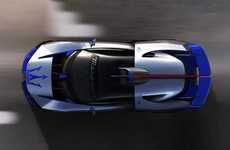
The 2016 Jaguar XF is 265 Pounds Lighter Than Its Predecessor
Rahul Kalvapalle — April 7, 2015 — Autos
References: jaguarlandrover & gizmag
The 2016 Jaguar XF is the second generation iteration of the four-door luxury XF sedan, and was unveiled at the 2015 New York International Auto Show.
The 2016 Jaguar XF comes with both rear and all-wheel drive and is highly aerodynamic thanks to front bumper vents that distribute air over the front wheels. Meanwhile, the front end is designed to improve airflow and shorten overhang.
The real highlight of this car however is its aluminum construction, which results in weight savings of 265 pounds compared to the previous Jaguar XF model. The car was built using a two-stage framing process wherein aluminum-intensive construction was combined with advanced high-strength steel and magnesium alloys.
Whereas people once valued cars that were heavy and bulky, the modern motorist is always up for some weight savings and the 2016 Jaguar XF offers just that without compromising on performance.
The 2016 Jaguar XF comes with both rear and all-wheel drive and is highly aerodynamic thanks to front bumper vents that distribute air over the front wheels. Meanwhile, the front end is designed to improve airflow and shorten overhang.
The real highlight of this car however is its aluminum construction, which results in weight savings of 265 pounds compared to the previous Jaguar XF model. The car was built using a two-stage framing process wherein aluminum-intensive construction was combined with advanced high-strength steel and magnesium alloys.
Whereas people once valued cars that were heavy and bulky, the modern motorist is always up for some weight savings and the 2016 Jaguar XF offers just that without compromising on performance.
Trend Themes
1. Lightweight Cars - The trend towards lightweight cars using advanced materials like aluminum for improved performance and fuel efficiency presents opportunities for automakers to innovate.
2. Aerodynamic Design - More cars are being designed with aerodynamic features like front bumper vents and improved airflow to reduce drag and improve fuel efficiency, creating new opportunities for designers and engineers.
3. Advanced Materials - Automakers are increasingly turning to advanced materials like aluminum, high-strength steel, and magnesium alloys for car construction, opening the door for new material innovations and partnerships.
Industry Implications
1. Automotive Manufacturing - Lightweight and aerodynamic car design using advanced materials has led to opportunities for automotive manufacturers to improve performance and fuel efficiency while reducing costs.
2. Materials Science - The trend towards advanced materials in car construction presents opportunities for material science researchers and companies to develop new materials for improved car performance and reduced environmental impact.
3. Engineering and Design Consulting - The push for lightweight and aerodynamic car design using advanced materials creates opportunities for engineering and design consulting firms to collaborate with automakers on innovative solutions.
0.3
Score
Popularity
Activity
Freshness























